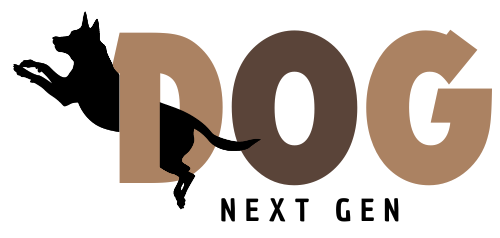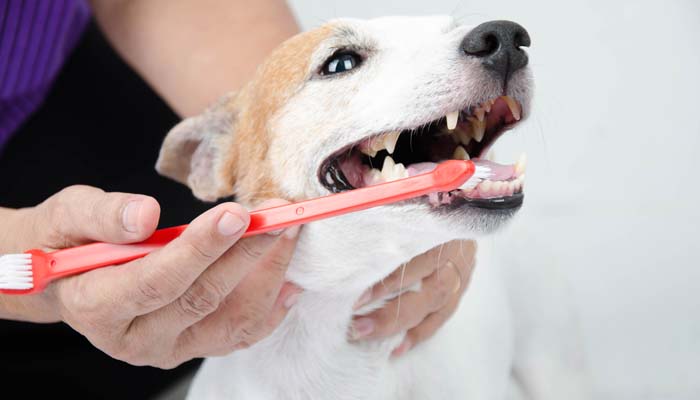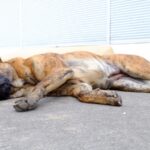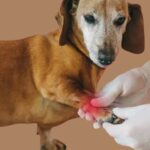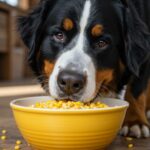Ever pondered about the total count of teeth in your furry friend, or why they possess so many?
Most of us, as proud pet parents, have come to understand the significance of dental health for our dogs’ overall wellness.
The routine of maintaining your dog’s dental health deserves equal attention as their body care and nutritional intake.
In a manner similar to humans, our canine buddies start with puppy teeth that eventually fall out, paving the way for adult teeth.
The count of teeth your dog possesses in adulthood fluctuates with age. Similarly to us, dogs have an array of different teeth types, each serving unique functions. The dental care regime for these specific teeth will be contingent upon numerous factors.
What are the different types of teeth your dog has?
There are four different types of teeth adult dogs have:
- Incisors
- Canines
- Premolars
- Molars
Incisors. Those are the small teeth in the front of your dog’s mouth. There should be six on the top and six on the bottom.
These are the teeth that help your dog rip meat off a bone and they are also the ones they use when they groom themselves. If you see your dog chewing their coat, they are likely using their incisors to get rid of mats, burs and fleas.
Canines. This type of adult dog teeth are oftentimes called “fangs”. They are the long pointy teeth on the sides of your dog’s mouth.
Those are the ones that can puncture things and break skin if the dog bites. Fangs are also the primary assistants for your dog when they’re trying to hold onto something. There should be two on the top jaw and two on the bottom jaw.
Premolars. They are located right behind your dog’s canines or “fangs”. Premolars are sharp-edged teeth mostly used for shearing.
If you give your dog a treat, a bone or a dog chew toy and you notice them chewing on the side of their mouth – they are using their premolars. There are 16 of these premolar teeth altogether: 8 on the top and 8 on the bottom.
Molars. These heavy duty teeth are located in the very back of the mouth. Molars are the flat-surfaced teeth mostly used for grinding.
There are two molars on each side of the top jaw and three on each side of the bottom jaw. Your dog will mainly use these for chewing food and possibly your slippers as well.
How many teeth do dogs have?
By the end of the developing stage, puppies will have about 28 baby teeth, which are often referred to as milk teeth.
These do not contain molars, and will fall out quickly to make room for permanent adult teeth when the time comes (usually takes 4 to 6 months).
When all of your puppies’ milk teeth fall out and adult teeth have finally grew in, your dog will have about 42 permanent adult teeth. Your pet should be around 6 months old at this point.
How do dogs teeth develop?
A lot of dog owners can proudly say that they’ve been bitten by those sharp little puppy teeth, and many of you have probably wondered why in the world are they so sharp.
Puppies don’t start developing teeth until they are about 4 weeks old. This is because up until that point they are drinking milk and don’t need teeth.
About 28 baby teeth come in when the puppy is around 4 weeks old, and they sure are sharp.
Those puppy teeth are mainly canines and incisors. And the reason dogs’ milk teeth are sharper than adult teeth is because they need the extra help to chew.
Since their jaws are not as strong and developed as those of grown up dogs, their sharper teeth make it easier to chew up hard food, treats, toys, and anything else they may find around your house.
Usually, puppies will begin losing teeth when they are between 4 and 6 months old.
During this phase most puppies go through a teething stage where they will chew up anything they can get their paws on.
Making sure there are plenty of harder teething dental chewy toys for them to chew on will help with this, but you may still come home to find your favorite shoes torn to bits.
How to care for your dog’s teeth?
At the time when your pet finally has all of their strong adult teeth, you should start developing good dental hygiene habits together with your pet.
Those dog teeth will now consist not only of canines and incisors, but there will also be quite a few molars.
Again, just like in humans, these are the only set of adult dog teeth your canine will get, so it is important to take very good care of them.
If you ignore proper oral care for your pet, your dog may end up with a form of dental disease. Here are some of the most common canine dental diseases:
- Chronic bad breath
- Gingivitis (or inflamed gums)
- Periodontal disease (an infection between the gums and the teeth)
- Even tumors or cysts in the mouth which will require drainage or surgery
Dental diseases do not show themselves in just one day, and pet owners have time to catch them before a disease reaches a crucial point.
Some early warning signs of dental hygiene problems in dogs can include:
- Broken teeth
- Bad breath
- Blood in their saliva
- Excessive drooling
- A decreased appetite
- Swollen gums
- Bleeding gums
- A brownish-yellow tartar buildup around the gum line
Most dogs generally don’t have cavities, but feeding them soft foods can cause debris to be left in the gum pockets that are at the base of the dogs teeth as well as promote dog arthritis if certain nutrition is left out.
This debris can lead to infections that will cause the gums to recede, exposing more of the teeth.
Infections like this can lead to bad breath and loss of teeth. Tartar can also build up on canine teeth much like it does on human teeth.
Therefore, brushing your dog’s teeth or having them cleaned regularly can greatly decrease the buildup.
If your dog is like most canines, they probably won’t be very accepting of the idea to brush their teeth.
To get your pet used to it, you should start out by massaging their lips with your finger for about a minute. Try to massage in a circular motion.
Doing this once or twice a day for a few weeks should help your dog become more comfortable and get them to allow you to move on to their teeth and gums. You may want to start brushing with your finger and then move up to a toothbrush once they are used to that.
There are also other things you can try if your dogs do not like having their teeth brushed.
Plenty of different dental sprays and various gels can be found online. You can apply those to your dog’s teeth a few times a week and they will help to remove plaque and tartar.
Additionally, you can also try an additive that you put in their water which helps keep plaque and tartar from building up.
Make sure to research all your options online, ask around at your local pet store or inquire your veterinarian for advice.
Feeding your dog hard dry dog food and allowing them to chew on hard biscuits and chew toys can help scrape some of the buildup off their teeth.
A good diet, high quality dog food and proper supplements and vitamins for dogs also play a role in dog teeth health.
Ensure you’re following proper guidelines on canine nutrition and buy only the best dog food for your dog’s specific breed and age. Check out our dog food rating system.
Brushing your dog’s teeth with a baking soda toothpaste or a toothpaste that is specially formulated for dogs will also increase their dental hygiene immensely, but that is usually very hard to accomplish.
As AVDC have been advising for a long time, you should try your best to keep all 42 of those adult canine teeth healthy and present, so your dog will not be susceptible to any kinds of dental diseases and infections.
Unfortunately, brushing has been proven as the best method for this above anything else.
FAQ
When should I start brushing my puppy’s teeth?
You should start brushing your puppy’s teeth as soon as their baby teeth come in, which is typically around 4 weeks of age. Starting early helps your puppy get used to the brushing process and promotes good oral hygiene habits.
How often should I brush my dog’s teeth?
Ideally, you should brush your dog’s teeth daily. However, if that’s not possible, aim for at least three times a week. Regular brushing helps prevent plaque and tartar buildup, which can lead to dental diseases.
What kind of toothpaste should I use for my dog?
Always use a toothpaste that’s specifically formulated for dogs. Human toothpaste contains ingredients like fluoride that can be harmful to dogs if swallowed. Dog toothpaste often comes in flavors like poultry or beef, which can make the brushing process more enjoyable for your pet.
What are the signs of dental problems in dogs?
Signs of dental problems in dogs can include bad breath, difficulty eating, red or swollen gums, excessive drooling, pawing at the mouth, and changes in behavior such as increased aggression or depression. If you notice any of these signs, it’s important to consult with your vet as soon as possible.
Can I use a human toothbrush to brush my dog’s teeth?
While it’s possible to use a human toothbrush for your dog, it’s generally recommended to use a toothbrush designed for dogs. Dog toothbrushes are angled and shaped specifically for dogs’ mouths, which makes the brushing process easier and more effective.
How can I keep my dog’s teeth clean without brushing?
In addition to brushing, there are other ways to help keep your dog’s teeth clean. These include dental chews and toys, dental diets, and water additives. However, these methods should be used as a supplement to brushing, not a replacement.
What is a professional dental cleaning for dogs and how often should it be done?
A professional dental cleaning for dogs, also known as a dental prophylaxis, is a thorough cleaning procedure that is performed under general anesthesia. It includes scaling (to remove dental plaque and tartar) and polishing. The frequency of professional dental cleanings depends on the individual dog, but most dogs benefit from having their teeth professionally cleaned once a year.
Final Words
In conclusion, maintaining your dog’s dental health is a crucial aspect of their overall well-being. Dogs, like humans, have different types of teeth that serve various functions, and their dental health can significantly impact their quality of life. Regular brushing, using dog-specific toothpaste, and providing dental chews can help keep your dog’s teeth clean and healthy. Additionally, being aware of the signs of dental problems can help you catch any issues early and seek appropriate veterinary care. Remember, a healthy mouth can contribute to a healthy, happy life for your furry friend.
